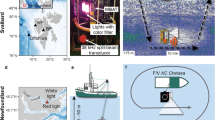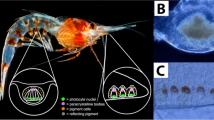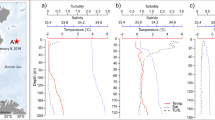Abstract
THE biological utility of the light organs of oceanic fishes has been the subject of much speculation1,2. According to one hypothesis the ventral photophores of some mesopelagic fishes in the upper regions of the sea may produce bioluminescence that matches the colour and intensity of environmental light passing downwards on either side of the fish. Such a system of camouflage could obscure the ventral outline of the fish when viewed from below3,4.
This is a preview of subscription content, access via your institution
Access options
Subscribe to this journal
Receive 51 print issues and online access
$199.00 per year
only $3.90 per issue
Buy this article
- Purchase on Springer Link
- Instant access to full article PDF
Prices may be subject to local taxes which are calculated during checkout
Similar content being viewed by others
References
Bolin, R., Proc. Pacific Sci. Congr., 10, 37 (1961).
Nicol, J., in Fish Physiology (edit. by Hoar, W. S., and Randall, D. J.), 3, 355 (Academic Press, New York, 1969).
Clarke, W., Nature, 198, 1244 (1963).
McAllister, D., J. Fish. Res. Bd. Can., 24, 537 (1967).
Denton, E., Phil. Trans. R. Soc., B 258, 285 (1970).
Anctil, M., and Gruchy, C., J. Fish. Res. Bd. Can., 27, 826 (1970).
Nicol, J., J. mar. biol. Ass. U. K., 39, 27 (1960).
Nicol, J., Symp. zool. Soc. Lond., 19, 27 (1967).
Dentonetal, E., Proc. Roy. Soc., B182, 145 (1972).
Bachus, R., Craddock, J. E., Haedrich, R. L., Shore, D. L., Teal, J. M., Wing, A. S., Mend, G. W., and Clarke, W. D., Science, N.Y., 160, 991–993 (1968).
Barham, E., Science, N.Y., 151, 1399 (1966).
Taylor, F., J. Fish. Res. Bd. Can., 25, 457 (1968).
Iwai, T., and Okamura, O., Sci. Rep. Yokosuka Cy. Mus., 5, 1 (1960).
Paxton, J., Bull. nat. Hist. Mus. Los Angeles, 13, 1 (1972).
Lawry, J., J. Anat. (in the press).
Munz, F., in Fish Physiology (edit. by Hoar, W. S., and Randall, D. J.), 5, 1 (Academic Press, New York, 1971).
Munk, O., Dana-Rep., 70 (1966).
Bolin, R., Sanford ichthyol. Bull., 1, 89 (1939).
Pumphry, R., in The Cell and Organism (edit. by Ramsay, J. A., and Wigglesworth, U. V.), 193 (Cambridge University Press, London, 1961).
Rossi, B., Optics, 3 (Addison-Wesley, London, 1959).
Lawry, J., Mar. Beh. Physiol., 1, 285 (1973).
Blaxter, J., and Curie, R., Symp. zool. Soc. Lond., 19, 1 (1967).
Harrison, C., Symp. zool. Soc. Lond., 19, 71 (1967).
Author information
Authors and Affiliations
Rights and permissions
About this article
Cite this article
LAWRY, J. Lantern Fish compare Downwelling Light and Bioluminescence. Nature 247, 155–157 (1974). https://doi.org/10.1038/247155a0
Received:
Revised:
Issue Date:
DOI: https://doi.org/10.1038/247155a0
This article is cited by
-
Light organ photosensitivity in deep-sea shrimp may suggest a novel role in counterillumination
Scientific Reports (2020)
-
Ecomorphological adaptations to bioluminescence in Porichthys notatus
Environmental Biology of Fishes (1995)
-
Mapping of antibody specificities to V H gene families
Immunogenetics (1989)
-
Eyes and extraocular photoreceptors in midwater cephalopods and fishes: Their roles in detecting downwelling light for counterillumination
Marine Biology (1979)
-
Adaptations of deep sea fishes
Environmental Biology of Fishes (1978)
Comments
By submitting a comment you agree to abide by our Terms and Community Guidelines. If you find something abusive or that does not comply with our terms or guidelines please flag it as inappropriate.



